
Sujet
Sunspots and solar prominences, 1973. Artist: Unknown
Légende
Sunspots and solar prominences, 1973. Image from Skylab's solar telescope. Sunspots are relatively cool areas on the Sun's surface, the photosphere. Their temperature is about 3800 degrees Kelvin, as opposed to around 5800 degrees on the rest of the photosphere, and they can measure as much as 50,000 kilometres across. The number of sunspots is greatest at the point in the cycle of solar activity known as the 'solar maximum', which occurs roughly every 11 years. They form when magnetic field lines below the surface become twisted and protrude through the photosphere. Sunspots are closely associated with the occurrence of solar flares, or prominences, massive eruptions of ionized hydrogen gas, often larger than the Earth, which arch away from the surface of the Sun. Some violent flares called Coronal Mass Ejections interact with the Earth's magnetic field and can disrupt radio communications and produce spectacular aurora displays.
Oxford Science Archive
Date
1973
Crédit
Photo12/Heritage Images
Notre référence
HRM19B64_091
Model release
Non
Licence
Droits gérés
Format disponible
30,1Mo (1,6Mo) / 28,8cm x 26,1cm / 3404 x 3088 (300dpi)